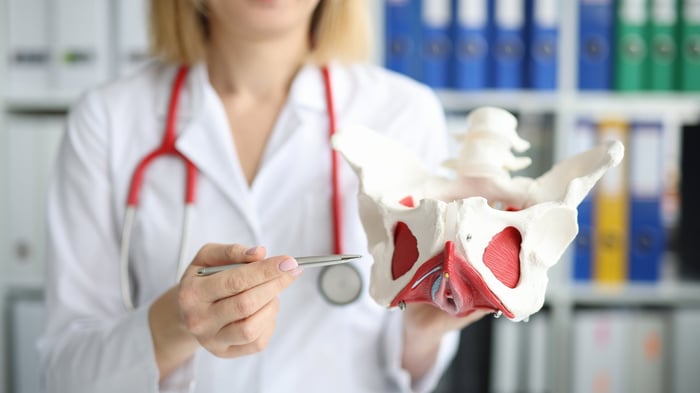
What Is Vaginismus And How Do You Manage It?
Jump To Section
So What is Vaginismus? If you have ever experienced pain or discomfort during vaginal penetration, you are not alone, vaginismus, dyspareunia, pelvic floor dysfunction affects up to 1 in 5 vulva owners in their lifetime. In a previous blog post, I talked about painful sex, particularly for people with a vulva. That piece covered painful sex more generally, whereas in this piece, I will talk about a specific condition for which pain during penetration is a key symptom. Read on for a deep dive into vaginismus.
 What is Vaginismus?
What is Vaginismus?
Vaginismus is a type of sexual dysfunction that affects people with a vulva. It causes pain during sexual intercourse, and any activity that involves vaginal penetration (including inserting a tampon, or having a gynaecological exam). This pain is due to vaginal muscles that involuntarily or persistently contract. These are extremely strong muscles which make up a person’s pelvic floor, and when they decide to tighten, there is no forcing the issue! Trying to insert something into the vagina when these muscles involuntarily tighten can result in pain which is described as burning and stinging, and is extremely unpleasant.
Different Types
There are two answers to what is vaginismus; primary, which is when vaginal penetration has never been successful, and secondary, which is when it was once possible, but no longer is. Secondary vaginismus is associated with factors such as menopause, gynaecologic surgery. and trauma.
The primary symptom of vaginismus is physical tightening of the vaginal muscles, but this can also be accompanied by psychological symptoms such as fear of penetration and loss of sexual desire associated with the act of penetration.
It may surprise you that you can find it in the Diagnostic and Statistical Manual of Mental Health Disorders (DSM). This is the handbook that provides standardised classification of mental disorders, and is used by mental health professionals for diagnosis of mental health conditions. Vaginismus is a type of female sexual dysfunction, and was included in the DSM IV as a stand alone condition. However in the 5th edition of the manual, it was combined with dyspareunia (which I talked about in my first blog post on painful sex) to form a single sexual dysfunction disorder which is marked by genital and pelvic pain during vaginal penetration. This change in how the condition is conceptualised by mental health professionals has had critiques levelled at it, which I will discuss in the next section.
 How is Vaginismus Diagnosed?
How is Vaginismus Diagnosed?
The research into vaginismus and dyspareunia continues, and the critiques levelled at the new pain/penetration disorder that rolls these two conditions together hinges on issues of diagnosis.
When discovering what is vaginismus and exploring a diagnosis, the doctor will first rule out any physical conditions that may be contributing the symptoms. A diagnosis may involve your doctor asking about history of sexual abuse or trauma. Vaginal spasming has been found to be associated with sexual and emotional abuse, so a discussion about your history in relation to this may take place. It is important you are aware of this and prepared with appropriate support should you need it.
Diagnosis will also usually involve an external examination to ensure that there is not an infection causing the involuntary muscle spasms. They may also wish to attempt an internal exam to rule out any other conditions. If an internal exam is required, communicate with your doctor about your concerns with the procedure and work with them to find the best way to complete it.
A diagnosis basically requires ruling out any other physical reason for the contraction of your pelvic floor muscles. It requires that the spasms are involuntary and that there is no other explanation for them. As with any medical condition, having a correct diagnosis is crucial for successful treatment.
 How is Vaginismus Treated?
How is Vaginismus Treated?
The real answer to what is Vaginismus is that its a sexual dysfunction which is primarily psychological in nature. For something that can cause significant pain and discomfort, this may seem like a cop out, a way of minimising the disorder, and not a true reflection of what is going on. However, it is important to remember that the mind is very powerful and if needed, it will create symptoms or reactions in the physical body to protect itself. With foundations in sexual trauma and emotional abuse, vaginal tightening and spasming results from subconscious attempts to avoid further harm. The treatment, therefore, focusses on psychological therapies combined with desensitization techniques like those used in the treatment of phobic disorders.
She-Ology 5 Pc Wearable Vaginal Dilator Set

$129.95
Revitalize and strengthen vaginal muscles with the contoured She-Ology™ 5-Piece Wearable Vaginal Dilator Set. The uniquely designed 5-piece dilator kits are ergonomically curved and gradually...… read more
Sex Therapy
Sex therapy and counselling is used in the treatment of vaginismus to help you better understand your feelings about your body and sex. This kind of therapy is delivered by specialised sex therapists and can be with individuals or couples. The techniques they use may differ, but they generally involve relaxation techniques, breathing exercises and mindfulness.
The techniques learned from counselling sessions can be used in conjunction with vaginal dilators. Vaginal dilators are cone shaped devices which when placed in the vagina and adjusted for size, helps the vaginal muscles stretch and increase their flexibility. These can also be used with your partner to build intimacy and in turn, move towards a safe penetrative experience.
 Physical Therapy
Physical Therapy
Physical therapy delivered by specialist pelvic floor physiotherapists can also be beneficial if you are finding insertion of dilators difficult. There are also medicines which provide pain relief and relaxation, and these can be used in conjunction with the other treatment options I have talked about. It may take a combination of these approaches to work out what is best for you.
In short, the fact is although it can be a distressing and painful condition, vaginismus can be successfully treated and managed. Although penetrative sex is not the be all and end all of intimate experiences, if you would like to get back to it (or even do it for the first time!), there are a range of treatments for pelvic pain, supported by a building body of evidence about the condition.
FAQs
What is vaginismus?
Vaginismus is a condition causing involuntary vaginal muscle contractions that make penetration painful or impossible.
Who experiences vaginismus?
Vaginismus affects people with a vulva and can interfere with sex tampon use, or medical exams like pap smears.
Are there different types of vaginismus?
Primary vaginismus is when a person has never been able to experience penetration without pain or complications. Secondary vaginismus occurs after normal penetration has been possible, potentially due to trauma.
What are symptoms of vaginismus?
Symptoms of vaginismus are both physical and psychological. Physical symptoms include vaginal tightening, spasming and pain. Psychological symptoms include anxiety, fear of penetration, and loss of desire.
How is vaginismus diagnosed?
Diagnosis is done with medical support and includes ruling out infections and physical ailments and may include discussions of both physical and psychological trauma. It was listed alone in the DSM but updated versions have vaginismus listed under "genito-pelvic pain/penetration disorder."
Is vaginismus treatable?
Treating vaginismus focuses on therapy and gradual desensitisation of the vagina. Sex therapy and counselling can help rebuild trust and comfort around intimacy, and pelvic floor physiotherapy and relaxation techniques also support healing.









